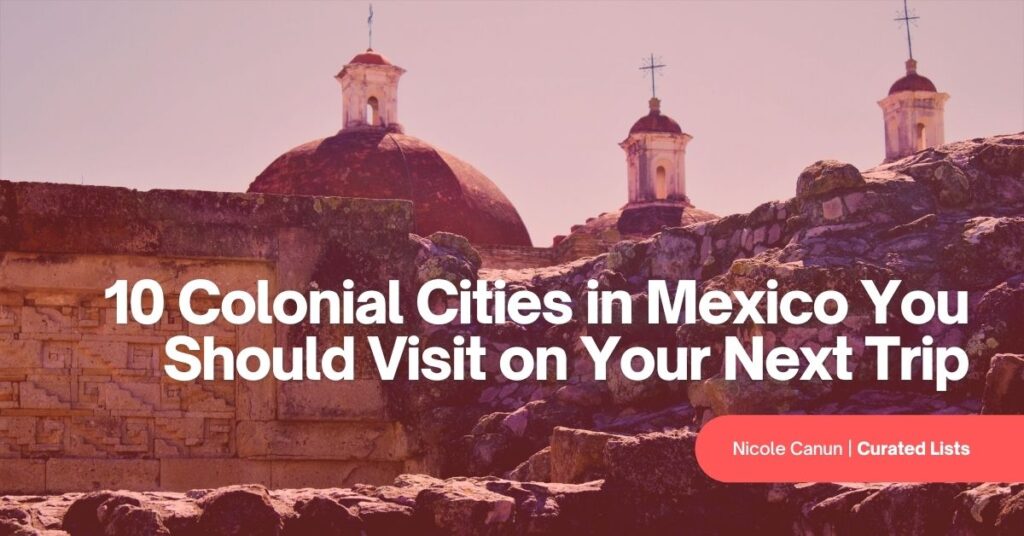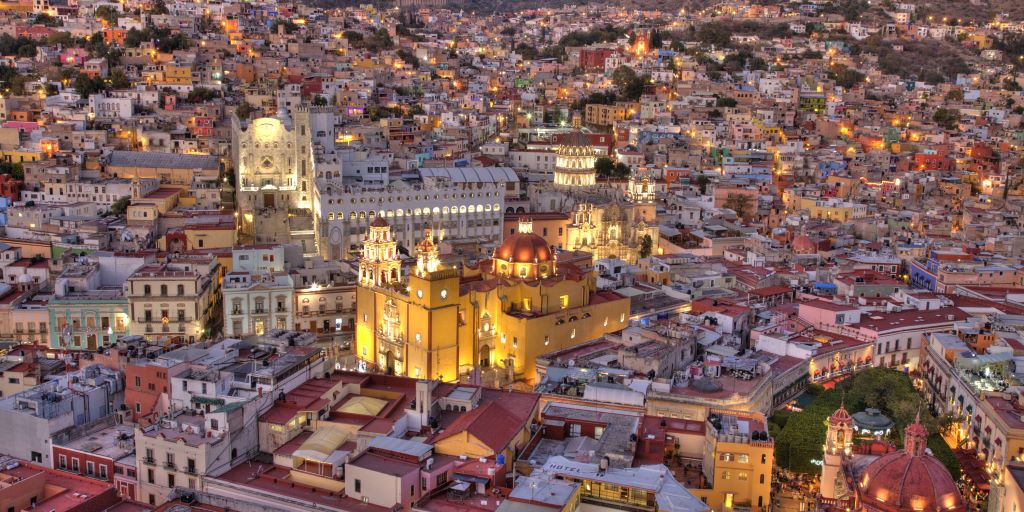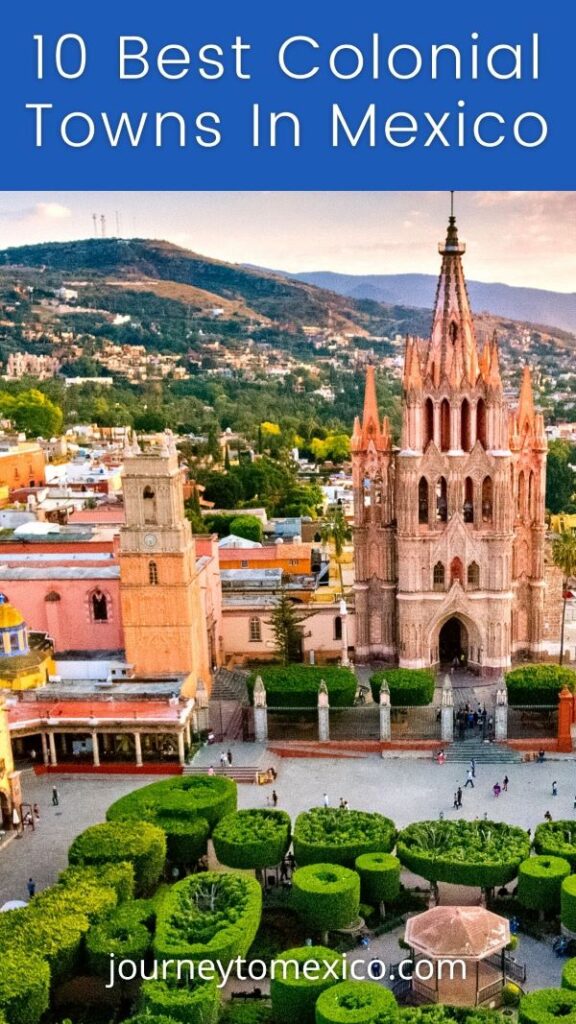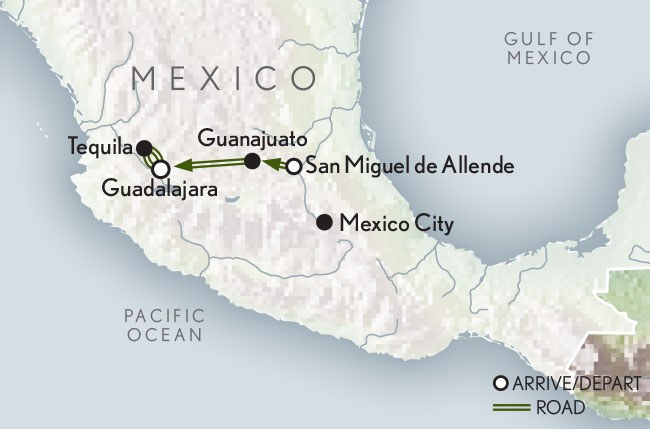Have you ever wondered what it would be like to step back in time and experience the rich cultural heritage of Mexico’s colonial cities? Well, get ready for an adventure because we’re about to take you on a journey through history! In this article, we’ll delve into the enchanting cobblestone streets, vibrant markets, and awe-inspiring architecture of Mexico’s colonial cities. From the bustling streets of Mexico City to the charming town of San Miguel de Allende, you’re in for a treat as we uncover the hidden gems and fascinating stories that make these cities a cultural paradise.
When you think of Mexico, you might envision sandy beaches and delicious tacos, but did you know that the country is also home to some of the most well-preserved colonial cities in the world? These cities are a testament to Mexico’s rich history and serve as a window into its colonial past. As you wander through the streets, you’ll come across grand churches with intricate facades, beautifully adorned courtyards, and colorful houses that seem frozen in time. Each city has its own unique charm and character, reflecting the fusion of indigenous and European influences that shape Mexico’s cultural identity. So get ready to immerse yourself in the sights, sounds, and tastes of Mexico’s colonial cities – there’s so much to discover and you won’t want to miss a thing! To find out more, read on and let the adventure begin.

Overview of Mexico’s Colonial Cities
Mexico’s colonial cities are an embodiment of the rich cultural heritage that dates back to the Spanish colonization era. These cities not only showcase stunning architectural marvels but also offer a glimpse into the fusion of Indigenous and European traditions that have shaped Mexican culture. From vibrant markets to vibrant festivals, each city has its unique charm and stories to tell. In this article, we will delve deep into the significance of Mexico’s colonial cities, explore their cultural diversity, and highlight some of the iconic cities that are a treasure trove of history and architectural splendor.
Understanding the significance of Mexico’s Colonial Cities
To truly appreciate the cultural heritage of Mexico, it is essential to understand the historical context of Spanish colonization. The Spanish conquest of Mexico in the 16th century had a profound impact on the country, shaping its culture, architecture, and traditions. The colonization brought together the indigenous roots of Mexico with the influence of Spanish culture, resulting in a unique blend that is reflected in the colonial cities.
Examining the historical context of Spanish colonization
Spanish colonization in Mexico began with the arrival of Hernan Cortes in 1519. The Spaniards sought to expand their empire and exploit the riches of the New World. They encountered ancient civilizations like the Aztecs, who had built magnificent cities and established advanced societal structures. The conquest led to the fall of the Aztec Empire and the rise of Spanish rule in Mexico, which lasted for over 300 years. This historical context laid the foundation for the development of Mexico’s colonial cities.
Assessing the influence of Spanish culture on Mexico
Spanish culture had a profound influence on Mexico’s colonial cities, particularly in terms of architecture, religion, and language. The Spanish introduced their architectural style, characterized by grand cathedrals, palaces, and plazas. These structures, adorned with intricate details and ornate facades, became iconic symbols of the colonial era. Additionally, Spanish religion, primarily Catholicism, became deeply rooted in Mexican culture, shaping religious practices and inspiring the construction of numerous churches and monasteries.

Exploring the Cultural Diversity
One of the most fascinating aspects of Mexico’s colonial cities is their cultural diversity. These cities are a melting pot of indigenous and European traditions, giving rise to a vibrant and unique cultural landscape.
Discovering the fusion of Indigenous and European traditions
Mexico’s colonial cities beautifully showcase the fusion of indigenous and European traditions. The indigenous populations of Mexico, with their rich cultural heritage and ancient traditions, played a crucial role in shaping the identity of these cities. From vibrant traditional clothing to indigenous languages, the influence of the indigenous communities is evident throughout the colonial cities. At the same time, the Spanish introduced their customs, language, and traditions, resulting in a captivating blend that is visible in the architecture, art, and cuisine of these cities.
Evaluating the role of religion in shaping Mexican culture
Religion has always held a significant place in Mexican culture, and this is especially true in the colonial cities. Catholicism, brought by the Spanish, became the dominant religion in Mexico and played a crucial role in shaping the cultural identity of the country. Churches and cathedrals became the center of religious and social life in the colonial cities, with elaborate processions and religious festivals becoming deeply ingrained in Mexican traditions. Religion continues to be a cornerstone of Mexican culture, and the colonial cities provide a window into this aspect of Mexican heritage.
Iconic Colonial Cities in Mexico
Mexico is home to several iconic colonial cities, each with its distinct character and historical significance. Let us delve into some of these cities and explore their cultural treasures.
Unveiling the charm of Guanajuato
Guanajuato is a city that oozes charm and provides a glimpse into the rich history of Mexico. Its origins can be traced back to the discovery of silver mines in the 16th century, which attracted settlers and led to the rapid growth of the city. Today, Guanajuato is a UNESCO World Heritage Site and captivates visitors with its colorful streets, intricate colonial architecture, and stunning landmarks such as the iconic Juarez Theater and the Basilica of Our Lady of Guanajuato.
Experiencing the magic of Morelia
Morelia, the capital of the state of Michoacán, is known for its architectural splendor and cultural heritage. The city was founded in 1541 and boasts a well-preserved historic center filled with colonial buildings and plazas. Morelia’s historic center is also recognized as a UNESCO World Heritage Site and is home to magnificent sites such as the Cathedral of Morelia and the aqueduct. The city is a haven for art lovers and history enthusiasts alike, with numerous museums and galleries showcasing the rich cultural heritage of the region.

Guanajuato: A Treasure Trove of History
Guanajuato, with its fascinating history and enchanting architecture, is a city that transports you back in time. Its origins can be traced back to the discovery of silver mines in the 16th century, which led to the rapid growth and prosperity of the city. Today, Guanajuato stands as a living testament to Mexico’s colonial past, with its well-preserved historic center declared a UNESCO World Heritage Site.
Tracing the origins of Guanajuato
Guanajuato’s history dates back to the pre-Hispanic era when the region was inhabited by various indigenous groups, including the Purépecha and Otomí. However, it was the discovery of silver in the nearby mountains that transformed Guanajuato into a thriving colonial city. The silver mines attracted settlers from Spain and other European countries, contributing to the city’s multicultural identity.
Exploring the iconic landmarks of Guanajuato
Guanajuato is brimming with architectural marvels and iconic landmarks that tell the story of its rich past. One of the most famous landmarks is the Juarez Theater, a magnificent neoclassical theater known for its stunning facade and ornate interior. Another must-visit site is the Basilica of Our Lady of Guanajuato, a majestic church with beautifully adorned altars and a rich religious history. The city is also renowned for its underground road system, a network of tunnels that were originally built to divert the Guanajuato River but now serve as roadways for cars and pedestrians.
Morelia: The Architectural Gem
Morelia is a city that seamlessly blends colonial architecture with stunning natural beauty. Founded in 1541, Morelia is recognized as a UNESCO World Heritage Site and stands as a testament to Mexico’s colonial legacy.
Delving into the history of Morelia
Morelia was founded by Antonio de Mendoza, the first viceroy of New Spain, and named after his birthplace in Spain. The city quickly became an important cultural and political center during the colonial era, attracting intellectuals and artists. Morelia played a significant role in the Mexican War of Independence and was the birthplace of several prominent figures in Mexican history. This rich history is evident in the city’s well-preserved historic center, which showcases a remarkable collection of colonial architecture.
Admiring the UNESCO World Heritage Sites in Morelia
Morelia’s historic center, also known as the Historic Center of Morelia, is a UNESCO World Heritage Site that enchants visitors with its architectural splendor. The Cathedral of Morelia, a towering example of Spanish Baroque architecture, is a sight to behold. Its intricate facade, adorned with statues and intricate detailing, is a testament to the skill and craftsmanship of the colonial era. Another iconic site is the aqueduct, a magnificent structure that spans over 1,700 feet and served as a vital water source for the city.

Oaxaca: The Cultural Capital
Oaxaca is a city that pulsates with culture and showcases the vibrant traditions of Mexico. Known for its rich cultural heritage, Oaxaca attracts visitors with its colorful markets, traditional crafts, and stunning colonial architecture.
Understanding the rich cultural heritage of Oaxaca
Oaxaca has deep indigenous roots, with Zapotec and Mixtec civilizations flourishing in the region long before the arrival of the Spanish. This indigenous influence is evident in the local cuisine, arts and crafts, and cultural practices that have been passed down through generations. The city itself is a melting pot of Zapotec, Mixtec, and Spanish traditions, resulting in a unique and vibrant cultural landscape.
Exploring the vibrant markets and traditional crafts of Oaxaca
One of the highlights of Oaxaca is its bustling markets, which offer a sensory overload of colors, scents, and tastes. The Mercado de Benito Juarez is a must-visit, where you can sample delicious traditional dishes like mole and tlayudas, as well as admire the craftsmanship of local artisans. Oaxaca is famous for its traditional crafts, including textiles, pottery, and woodwork, which are often made using ancient techniques passed down through generations. Exploring the markets and interacting with local artisans provides a fascinating insight into Oaxaca’s cultural heritage.
San Miguel de Allende: An Artistic Haven
San Miguel de Allende is a city that has become synonymous with art and creativity. With its charming streets, vibrant art scene, and stunning architectural marvels, the city continues to inspire artists and visitors from around the world.
Uncovering the artistic scene in San Miguel de Allende
San Miguel de Allende has long been a haven for artists, attracting creatives from various disciplines. Its vibrant art scene is evident in the numerous galleries, art schools, and workshops that line the streets. One of the highlights is the Instituto Allende, a prestigious art school that offers courses in painting, sculpture, photography, and more. The city also hosts several annual art festivals and events, such as the San Miguel Art Walk, which showcase the talent and creativity of local and international artists.
Appreciating the colonial architecture and vibrant festivals of San Miguel de Allende
San Miguel de Allende’s colonial architecture is a sight to behold, with its well-preserved buildings, cobblestone streets, and beautifully adorned facades. The city’s historic center, a UNESCO World Heritage Site, is a treasure trove of architectural gems, including the iconic Parroquia de San Miguel Arcángel. This pink-hued church, with its neo-Gothic towers and intricate details, has become a symbol of the city. San Miguel de Allende is also known for its vibrant festivals, such as the Day of the Dead celebrations and the San Miguel Carnival, where the streets come alive with music, dance, and colorful costumes.

Querétaro: A Glimpse into the Past
Querétaro, with its rich history and well-preserved colonial architecture, offers a glimpse into Mexico’s past. The city’s charming streets and historic buildings narrate the story of its significance during the Spanish colonization era.
Examining the historic significance of Querétaro
Querétaro played a crucial role in Mexico’s fight for independence from Spanish rule. It was in this city that the 1810 conspiracy, known as the Querétaro Conspiracy, was hatched, which ultimately led to the Mexican War of Independence. The city’s historic center showcases its colonial past, with its narrow alleys, baroque facades, and grand plazas. Exploring Querétaro is like stepping back in time and immersing oneself in the rich history of the region.
Discovering the UNESCO World Heritage Sites in Querétaro
Querétaro is home to several UNESCO World Heritage Sites that embody the city’s historical and architectural significance. One of the must-visit sites is the Aqueduct of Querétaro, an impressive engineering marvel that spans over 1,280 meters. The aqueduct, built in the 18th century, served as a vital water source for the city. Another iconic site is the Historic Monuments Zone of Querétaro, which encompasses the historic center and showcases the well-preserved colonial architecture of the city.
Puebla: The City of Angels
Puebla, known as the City of Angels, is a captivating city that reflects the religious heritage and architectural splendor of Mexico. With its magnificent colonial buildings and rich culinary traditions, Puebla is a destination that captivates visitors.
Learning about the religious heritage of Puebla
Puebla is deeply rooted in religious traditions and is home to several iconic religious sites. The city is known for its ornate churches, with the Cathedral of Puebla being one of the most impressive. This majestic cathedral, built in the 16th century, showcases a unique blend of architectural styles, including Renaissance, Gothic, and Baroque. Puebla is also famous for its religious festivals, such as the Feast of the Assumption and the Procession of the Lord of the Conquest, which attract pilgrims from all over Mexico.
Admiring the magnificent colonial buildings in Puebla
Puebla’s historic center, a UNESCO World Heritage Site, is a treasure trove of colonial architecture. The city boasts over 2,600 historic buildings, each with its unique charm and story to tell. The brightly colored facades, intricate tile work, and ornate details make Puebla a visual delight. One of the most iconic buildings is the Casa de los Muñecos, known for its facade adorned with blue and white tiles. Exploring the streets of Puebla is like stepping into a living museum of colonial architecture.
Merida: The White City
Merida, known as the White City, is a city that combines Mayan and colonial influences to create a unique architectural style. With its vibrant cultural festivals and stunning architectural landmarks, Merida is a city that celebrates its diverse heritage.
Exploring the unique blend of Mayan and Colonial architecture in Merida
Merida is a true testament to the blending of Mayan and colonial influences in its architecture. The city’s historic center is home to numerous colonial buildings, with their bright white facades and ornate details standing in contrast to the vibrant colors of the region. The unique architectural style is evident in buildings such as the Merida Cathedral and the Palacio de Gobierno, which showcase a fusion of Mayan motifs and Spanish colonial design elements.
Experiencing the vibrant cultural festivals of Merida
Merida is a city that celebrates its cultural heritage through vibrant festivals and events. One of the most famous festivals is the Hanal Pixan, a Mayan tradition that honors the souls of the departed. During this time, the city comes alive with music, dance, and colorful altars adorned with offerings. Another must-see event is the Vaquería, a traditional Yucatecan dance performance that showcases the region’s cultural diversity. These festivals provide a unique opportunity to immerse yourself in the rich cultural traditions of Merida.
Guanajuato’s International Cervantino Festival
Guanajuato’s International Cervantino Festival, also known as the Cervantino Festival, is a cultural extravaganza that celebrates the arts and showcases Mexico’s rich heritage. Named after Miguel de Cervantes, the author of Don Quixote, this festival has become one of Mexico’s most important cultural events.
Unveiling the history and significance of the Cervantino Festival
The Cervantino Festival was first held in 1972, with the aim of promoting cultural exchange and celebrating the arts. It quickly gained international recognition and has since become a platform for artists from around the world to showcase their talent. The festival features a diverse program that includes music, theater, dance, visual arts, and literature, attracting both renowned artists and emerging talents.
Highlighting the diverse cultural events during the festival
The Cervantino Festival offers a diverse array of cultural events that cater to different artistic tastes. From classical music performances to avant-garde theater productions, there is something for everyone. The festival takes place in various venues throughout Guanajuato, including theaters, plazas, and historic buildings, adding to the unique ambiance of the event. Cultural enthusiasts flock to Guanajuato during the festival to experience the vibrant energy and creativity that fills the city.
Preserving Mexico’s Colonial Heritage
Preserving Mexico’s colonial heritage is of utmost importance, as these cities serve as living reminders of the country’s history and cultural diversity. Efforts have been made to protect and restore the colonial architecture, ensuring that future generations can continue to appreciate and learn from these cultural treasures.
Examining the efforts to protect and restore colonial architecture
Various organizations and government bodies in Mexico have recognized the need to protect and restore colonial architecture. Through preservation projects and initiatives, efforts have been made to maintain the integrity of historical buildings and ensure that they are not lost to urban development or neglect. By preserving these architectural gems, Mexico can maintain a strong connection to its past and provide a glimpse into the country’s cultural heritage.
Evaluating the impact of tourism on Mexico’s colonial cities
Tourism plays a significant role in the economy of Mexico’s colonial cities, but it also poses challenges in terms of preserving the cultural heritage. The influx of tourists can result in increased pressure on infrastructure and a potential loss of authenticity. However, responsible tourism practices that prioritize preservation and respect for local traditions can help mitigate these challenges. It is vital for both visitors and locals to actively contribute to the preservation of Mexico’s colonial heritage by being mindful of their impact on these cities.
Conclusion
Mexico’s colonial cities are cultural treasures that deserve to be celebrated and preserved. From the architectural marvels to the vibrant festivals, these cities offer a window into the rich history and diverse cultural heritage of Mexico. By immersing yourself in the beauty and charm of these cities, you not only gain a deeper understanding of Mexican culture but also contribute to the preservation and promotion of these precious cultural gems. So, embark on a journey through Mexico’s colonial cities and let the stories of the past guide you towards a greater appreciation for the cultural heritage they hold.
